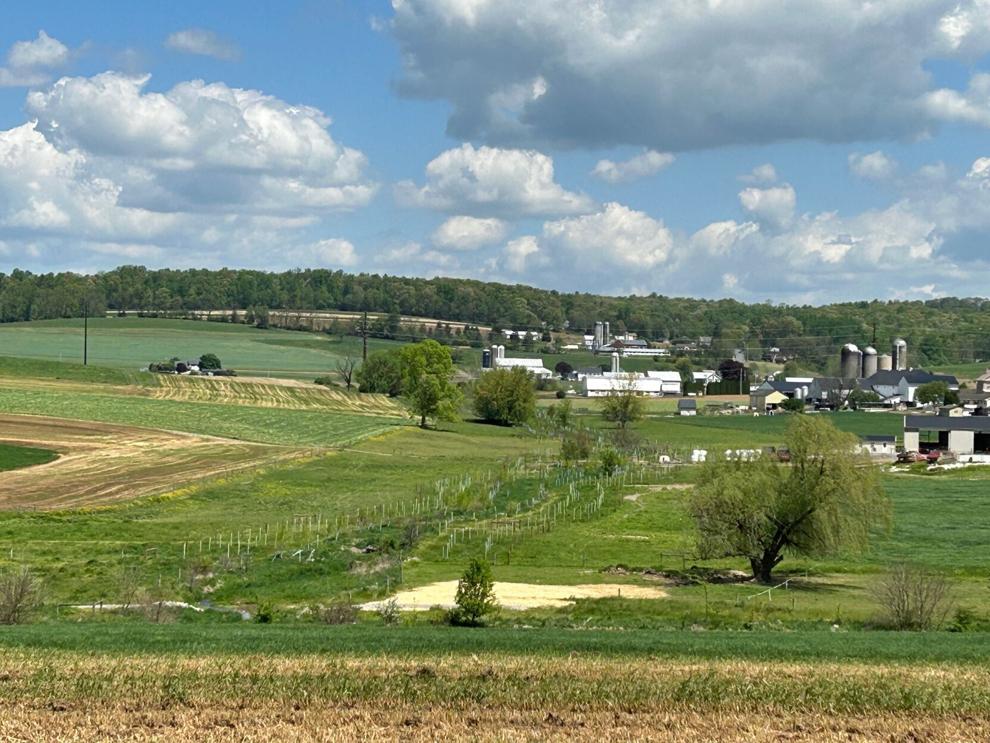
07 Aug Caernarvon Township farmers model watershed restoration at Hammertown Run
Published on: LNP LancasterOnline – Article Link
August 1, 2024
Image Credit: Lamonte Garber
A 1.25-mile stretch of Caernarvon Township waterway is being hailed as a potential national model for stream restoration that shows what’s possible when long-term community engagement work among Plain Sect farmers is leveraged to produce concentrated conservation work.
It took 15 years and a little more than $170,000 to complete streamside plantings along the unnamed tributary nicknamed Hammertown Run, and scientists say ongoing data collection is a unique opportunity to monitor an aquatic ecosystem in recovery and inform Pennsylvania’s efforts to improve local waterways enough to merit removal from the federal impaired waters list.
The unnamed tributary nicknamed Hammertown Run starts in the forest, flows past dairy farms and crop fields, and joins up with the Little Conestoga Creek near Churchtown before its waters continue into the Conestoga River and ultimately enter the Chesapeake Bay.
A large team of nonprofits, consultants and township officials invested in conservation work along Hammertown Run, with the first streamside plantings going in fall 2009 and the last stretch receiving trees this June.
Raymond Lee King, the second farmer along the stream to start restoration work, said 12 years of tree growth have transformed his streamside property.
“It’s really neat when you go down in there and see how it really works when there’s high water and what happens to the grasses and how it protects the soil, the banks,” King said.
King’s streamside trees were planted in 2012. In subsequent years he also received funding for a manure storage unit and a no till drill that he uses to seed cover crops. King grows corn, alfalfa and soybeans on his 80 acres. He still has a few cows, but no longer milks.
“What we have in this community is really a homegrown effort to work together to improve the conditions of the stream and the entire watershed that surrounds it,” said Lamonte Garber, the watershed restoration coordinator at the Chester County-based Stroud Water Research Center.
Garber emphasized that the streamside plantings were only one step in the area’s conservation work. Since 2010, he estimated around $500,000 in public funds have gone toward best management practices such as improved manure storage and barnyard runoff controls, not counting practices farmers implemented on their own, such as no till and cover crops.
Farmer meetings were successful in turning out the neighbors, with some participants providing food as an extra draw, said Sarah Xenophon from the Ephrata-based consultancy TeamAg. The latest meeting was in early July, and further engagement efforts are in the works.
“It’s like a block party for clean water,” Xenophon said.
Engaging the community
Caernarvon Township set up an Agricultural Advisory Committee in 2008, and committee member Gary Van Dyke said efforts to preserve farms along the Hammertown Run stretch kickstarted the conservation efforts.
There are seven farms that border the waterway, comprising 500 acres that cover about half the total watershed. Between November 2007 and August 2023, all the farms were preserved through the township’s partnerships with the Lancaster Farmland Trust and the Agricultural Preserve Board, Van Dyke said.
“It takes time to convince and get land preserved, but we’ve been making progress,” Van Dyke said.
The seven farms are all small dairy farms, although three have been converted to crop farms after retiring their dairy operations. All the owners are Amish or Old Order Mennonite.
In addition to the streamside tree plantings, farmers wrote conservation and manure management plans and implemented soil and erosion controls to reduce runoff from barn and paddock areas.
The conservation work grew through word of mouth, King said.
“There was nobody coming in with force,” King said. “It’s all just handed down, one person seeing what the other guy is doing, and that’s how it grew.”
Penn State professor Anil Kumar Chaudhary, who served as the well water testing leader in the watershed, said a Hammertown farmer was willing to share hours worth of stories comparing his experiences to Chaudhary’s work in India.
That farmer then helped spread the word about Penn State’s ongoing efforts to study how water quality affects animal and human health.
“I have a few cheerleaders in the community now,” Chaudhary said.
Despite the level of farmer engagement, the average citizen of Caernarvon Township probably doesn’t know the full extent of all the conservation work that has come together to improve the tributary, said Board of Supervisors chair Bob Lauffer.
The township has talked to a participating farmer about potentially putting up a sign and possibly including a picnic table with brochures to better spread the word about the restoration work, Lauffer said.
One next step is to connect farmers with the owners of forested properties further upstream, Lauffer said.
“If the water stays cold and clean up there, there’s a better chance it will stay cold and clean for longer,” Lauffer said.
Modeling long-term monitoring
At Hammertown Run, Stroud Water Research Center already has 10 years of data showing levels of aquatic insects and other macroinvertebrates whose presence helps indicate the health of a stream.
The center is funding six monitoring stations, which is an unusually dense concentration, said senior research scientist John Jackson.
Scientists are measuring the rate and degree of improvement in the stream’s health to provide a detailed model of what is possible when a concentrated cleanup effort occurs in a small geographic area.
“It’s a learning opportunity not just for Hammertown but for all of Lancaster County, all of Pennsylvania, stream restoration in general as a science,” Jackson said.
There are 100 to 200 different aquatic insect species in the 10 to 20 miles around Hammertown Run, so summarizing the response of multiple species helps provide a benchmark for collective improvement, Jackson said.
Data from 2013 to 2022 has already been processed, and three of the sites do show modest improvement, Jackson said.
The conservation and monitoring efforts are a long-term investment.
“We just put in a bunch of trees just this last year,” Jackson said. “Their impact is still a decade away.”
Farmers are also awaiting the results of TeamAg soil testing and nitrogen tests done on corn stalks to measure how much nitrogen is available in the soil and how much nitrogen the corn plants actually used. The data will inform nitrogen application rates for this fall and next year.
“By collecting this in-season data, farmers can save money, reduce nutrient runoff, and fine tune their yield goals,” Xenophon said.
Nitrogen and phosphorus are nutrients that can harm aquatic ecosystems when runoff levels are too high. Chesapeake Bay watershed states have set goals around reducing nutrient runoff and sediment pollution. The latest annual Chesapeake Bay Report Card from the University of Maryland’s Center for Environmental Science indicates these upstream efforts are having an effect, with the Upper Bay – the region Lancaster County drains into – scoring the second-highest for ecosystem health.
Alongside previously mentioned collaborators, the Chesapeake Bay Foundation, Lancaster County Conservation District, Lancaster Clean Water Partners and the U.S. Department of Agriculture’s Natural Resources Conservation Service and Farm Service Agency contributed to this project.


No Comments